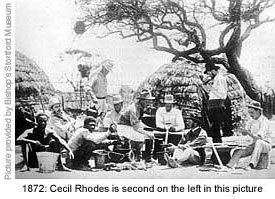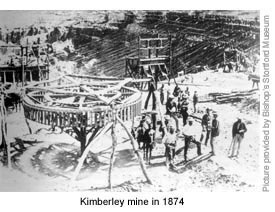|
 The principle African power on the Zimbabwe Plateau in the 1880s was the Ndebele (Matabele) Kingdom, ruled by King Lobengula from his capital, Bulawayo. Following the discovery of gold on the Rand in 1886, Bulawayo became inundated with white speculators seeking his permission to prospect. Cecil Rhodes, fearing the land would ‘fall’ to the Germans or to the Transvaal before he himself was ready to act, persuaded a friend to send a former missionary, John Moffat, to see Lobengula. Having previously worked among the Ndebele and learned their language, Moffat soon gained Lobengula's trust and in 1888 a treaty was signed in which he undertook not to make any deals with other powers without first consulting Britain. The principle African power on the Zimbabwe Plateau in the 1880s was the Ndebele (Matabele) Kingdom, ruled by King Lobengula from his capital, Bulawayo. Following the discovery of gold on the Rand in 1886, Bulawayo became inundated with white speculators seeking his permission to prospect. Cecil Rhodes, fearing the land would ‘fall’ to the Germans or to the Transvaal before he himself was ready to act, persuaded a friend to send a former missionary, John Moffat, to see Lobengula. Having previously worked among the Ndebele and learned their language, Moffat soon gained Lobengula's trust and in 1888 a treaty was signed in which he undertook not to make any deals with other powers without first consulting Britain.
Rhodes then founded De Beers Consolidated Mining Company and contrived, under a Trust Deed, to use the company’s funds to acquire any African territory, if he so wished. But to get British Government approval for this he first needed concessionary authority from Lobengula and sent a three-man team, headed by his partner Charles Rudd, to negotiate with him. Two months later a deal was struck and a Concession signed which, so far as Lobengula understood, would give him £100 a month and 100 rifles in exchange for allowing a handful of whitemen to dig for minerals in his Kingdom.
But the King had been deceived. The resident missionary, Reverend Helm, believed removal of the pagan Lobengula was the only way to persuade the Ndebele to turn to Christianity, and gave a ‘deliberate’ mis-translation of the Concession. It actually gave Rhodes and his agents permission to take 'whatever action they considered necessary' to exploit the mineral wealth of his Kingdom. They could even take over the Kingdom if they thought it 'necessary'.
|
|
Rhodes then returned to London, and using funds from De Beers founded the British South Africa Company (BSA). Backed by Rothschilds, it naturally attracted many prominent investors. He then asked the British Government for a Royal Charter granting him permission to colonise Central Africa under the authority of the British flag. He charmed his way through the British establishment, and in October 1889 Queen Victoria signed the Royal Charter that authorised the BSA Company to run territory north of the Limpopo in Britain's name. Rhodes was also given the power of attorney, in effect giving him permission to act as he saw fit without any prior consultation. He had complete control.
Lobengula, realising he’d been tricked, rejected the original Concession but his protests were totally ignored by the British Government. Rhodes, knowing his idea to gain control of the colony was not going to plan, then devised a secret plot to assassinate or kidnap Lobengula, but incompetence on the part of the two amateur agents sent to carry out the deed led to its discovery and the scheme was quickly covered up by the British Government.
 Rhodes then planned to establish a colony to the east of Lobengula’s kingdom in Mashonaland, and with the promise of free land and gold claims recruited 200 white settlers. Accompanied by 200 heavily armed police they entered into Mashonaland and at the heart of it established a township which they named Salisbury (now Harare) after the British Prime Minister of the day, Lord Salisbury. Land claims were quickly staked, but the pioneers' enthusiasm soon turned to anger when they discovered the old abandoned gold workings had already been heavily mined by the ancient Shoner miners, and that there were no easy fortunes to be made. Rhodes then planned to establish a colony to the east of Lobengula’s kingdom in Mashonaland, and with the promise of free land and gold claims recruited 200 white settlers. Accompanied by 200 heavily armed police they entered into Mashonaland and at the heart of it established a township which they named Salisbury (now Harare) after the British Prime Minister of the day, Lord Salisbury. Land claims were quickly staked, but the pioneers' enthusiasm soon turned to anger when they discovered the old abandoned gold workings had already been heavily mined by the ancient Shoner miners, and that there were no easy fortunes to be made.
By now, though, investors in the BSA Company were expecting early dividends, so Rhodes needed to find some other way of getting a financial reward. For this he turned his attention once again to the Ndebele Kingdom. With its large cattle herds, fertile land and possible mineral wealth the temptation proved too great for the previously disappointed pioneers, and they were eager for a fight.
A minor border dispute between Lobengula and the Company led to the British High Commissioner in Cape Town giving tacit approval for an invasion, which Rhodes authorised in 1893. Led by by Rhodes's long-term friend Dr Leander Starr Jameson, the small force was greatly outnumbered by the Ndelebe army, but superior weaponry won them many battles. By December that year Bulawayo was in flames and the ageing Lobengula, who had fled the capital, died soon after.
With Lobengula dead, Jameson declared the BSA Company would assume authority and that all Ndebele land and cattle now belonged to the Company. Both cattle and farms were then given piecemeal to the jubilant white victors and the value of the Company shares soared on the London Stock Exchange. Although Rhodes never settled in the colony it was named Rhodesia in his honour in 1897.
|


 The principle African power on the Zimbabwe Plateau in the 1880s was the Ndebele (Matabele) Kingdom, ruled by King Lobengula from his capital, Bulawayo. Following the discovery of gold on the Rand in 1886, Bulawayo became inundated with white speculators seeking his permission to prospect. Cecil Rhodes, fearing the land would ‘fall’ to the Germans or to the Transvaal before he himself was ready to act, persuaded a friend to send a former missionary, John Moffat, to see Lobengula. Having previously worked among the Ndebele and learned their language, Moffat soon gained Lobengula's trust and in 1888 a treaty was signed in which he undertook not to make any deals with other powers without first consulting Britain.
The principle African power on the Zimbabwe Plateau in the 1880s was the Ndebele (Matabele) Kingdom, ruled by King Lobengula from his capital, Bulawayo. Following the discovery of gold on the Rand in 1886, Bulawayo became inundated with white speculators seeking his permission to prospect. Cecil Rhodes, fearing the land would ‘fall’ to the Germans or to the Transvaal before he himself was ready to act, persuaded a friend to send a former missionary, John Moffat, to see Lobengula. Having previously worked among the Ndebele and learned their language, Moffat soon gained Lobengula's trust and in 1888 a treaty was signed in which he undertook not to make any deals with other powers without first consulting Britain. Rhodes then planned to establish a colony to the east of Lobengula’s kingdom in Mashonaland, and with the promise of free land and gold claims recruited 200 white settlers. Accompanied by 200 heavily armed police they entered into Mashonaland and at the heart of it established a township which they named Salisbury (now Harare) after the British Prime Minister of the day, Lord Salisbury. Land claims were quickly staked, but the pioneers' enthusiasm soon turned to anger when they discovered the old abandoned gold workings had already been heavily mined by the ancient Shoner miners, and that there were no easy fortunes to be made.
Rhodes then planned to establish a colony to the east of Lobengula’s kingdom in Mashonaland, and with the promise of free land and gold claims recruited 200 white settlers. Accompanied by 200 heavily armed police they entered into Mashonaland and at the heart of it established a township which they named Salisbury (now Harare) after the British Prime Minister of the day, Lord Salisbury. Land claims were quickly staked, but the pioneers' enthusiasm soon turned to anger when they discovered the old abandoned gold workings had already been heavily mined by the ancient Shoner miners, and that there were no easy fortunes to be made.